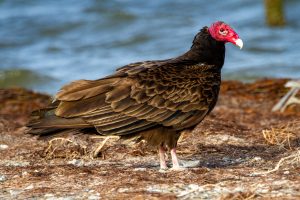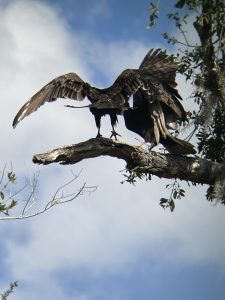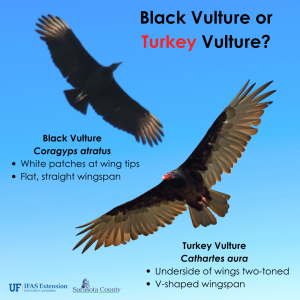In both temperate and tropical climates in the Western hemisphere of the world, fall marks a time of transition. Rainy season to dry season, or summer through winter, the natural world around us changes. As oak trees grow heavy with their acorn crops, the wildlife that depend upon them to get through the next season gather and cache the nutritious nuts. These changes offer us the opportunity to reflect on warm memories and notice what is going on in the world around us. This November, we’re celebrating Wildlife Wednesdays with unique stories of gratitude for the animal kingdom. From pollination to pest management, follow along with this month-long blog series each Wednesday to learn why we have much to thank the wild, wacky world of wildlife for.

An Underappreciated Hero
First up is the turkey vulture (Cathartes aura). Now you may be thinking- weird choice, but we have lots to give thanks for when it comes to our red-headed royalty of the sky! Turkey vultures are scavengers, cleaning the environment of dead and decaying animal carcasses, which helps to keep the spread of disease at bay. While we may not be able to stomach even the thought of a turkey vulture’s main course, this specialized avian scavenger’s stomach acid has a pH of just above zero, which neutralizes even some of the most dangerous disease-causing pathogens. This pH level rivals highly corrosive battery acid, while our own stomach acid lies in the range of 1-2 on the pH scale. Read on to discover an unexpected service that vultures provide in our ecosystems.
Vultures and Climate Change
Did you know that as an animal’s body decays, it releases greenhouse gases? Yes, those same gases that can contribute to climate change when produced in excess. According to a study shared within the Scientific American, a vulture’s incredibly keen sense of smell allows it to locate a meal as it soars powerfully overhead, quickly consuming the animal before it can release those extra greenhouse gases into the atmosphere. Furthermore, this study found that “Collectively, vultures in the Americas keep about 12 million metric tons of CO2 equivalent out of the atmosphere annually” (Rose, 2022, par. 4). Thank you vultures!
More On Turkey Vultures

While turkey vultures’ bright, featherless, red heads are quite the unique and eccentric fashion statement, they serve the important purpose of helping them stay clean and free of lingering debris while feeding.
Their sharp, curved beak is an important adaptation that enables them to access their food without the use of the powerful talons that other birds of prey such as osprey, owls, and hawks use to grasp their prey and stabilize it as they eat. Remember that extremely acidic stomach acid that turkey vultures possess? Well, this comes in handy for another unusual purpose. These birds will often excrete waste on their legs and feet, as the acidic substances help keep them free of bacteria, and aid in cooling down their body on hot days (Wildlife Center of Virginia)!
Unlike other raptors whose nests are often conspicuously located atop tall trees and posts, turkey vultures prefer to lay their eggs on the ground, covered by vegetation, in hollowed out trees, or even in caves.

Showing gratitude for One of Nature’s Extraordinary Recyclers
The natural world is an excellent example of an efficient, “zero waste” system, where energy is reused and recycled throughout the ecosystem. Vultures play an important role in the functioning of this sophisticated system.
Around the globe, vultures of a variety of species face declining populations due to persecution, misinformation, and both accidental and intentional poisoning with substances such as lead and some livestock medications that are transferred to vultures as they consume carrion. Vultures are protected both federally and by the state here in Florida as migratory birds, and as such, they may not be harmed or killed. Help protect this ecologically significant species by sharing this story of gratitude with others, and educating those around you about the important role that vultures play in our world.
See you next week for another story of gratitude!
Read more stories in this series here.
Learn more about Florida’s raptor species with these additional resources and a free Wild Sarasota webinar.
Resources:
Rose, I. (2022, September 20).Vultures Prevent Tens of Millions of Metric Tons of Carbon Emissions Each Year. Scientific American. https://www.scientificamerican.com/article/vultures-prevent-tens-of-millions-of-metric-tons-of-carbon-emissions-each-year/#:~:text=Collectively%2C%20vultures%20in%20the%20Americas,out%20of%20the%20atmosphere%20annually.
Wildlife Center of Virginia. (2023). Vulture Facts. https://www.wildlifecenter.org/vulture-facts
by Zahir Ringgold Cordes
Source: UF/IFAS Pest Alert
Note: All images and contents are the property of UF/IFAS.



